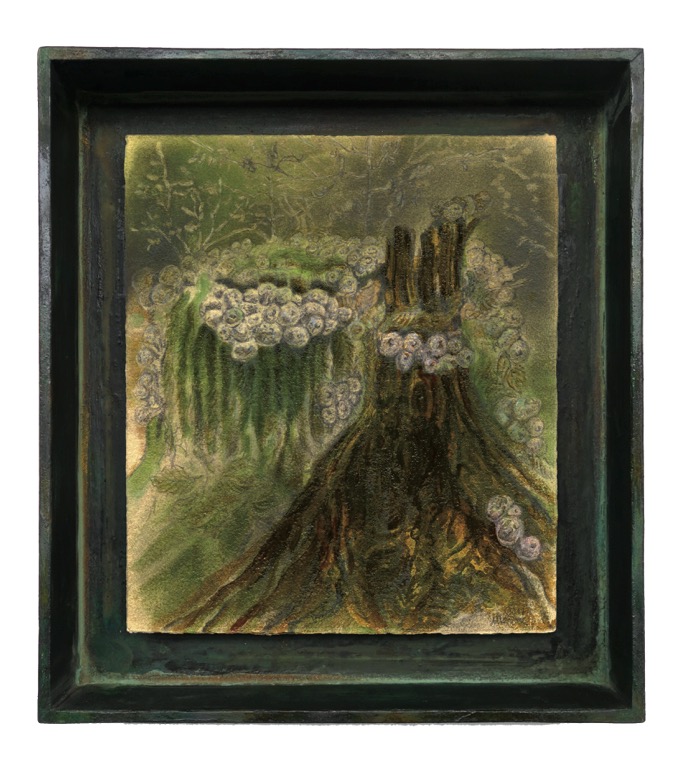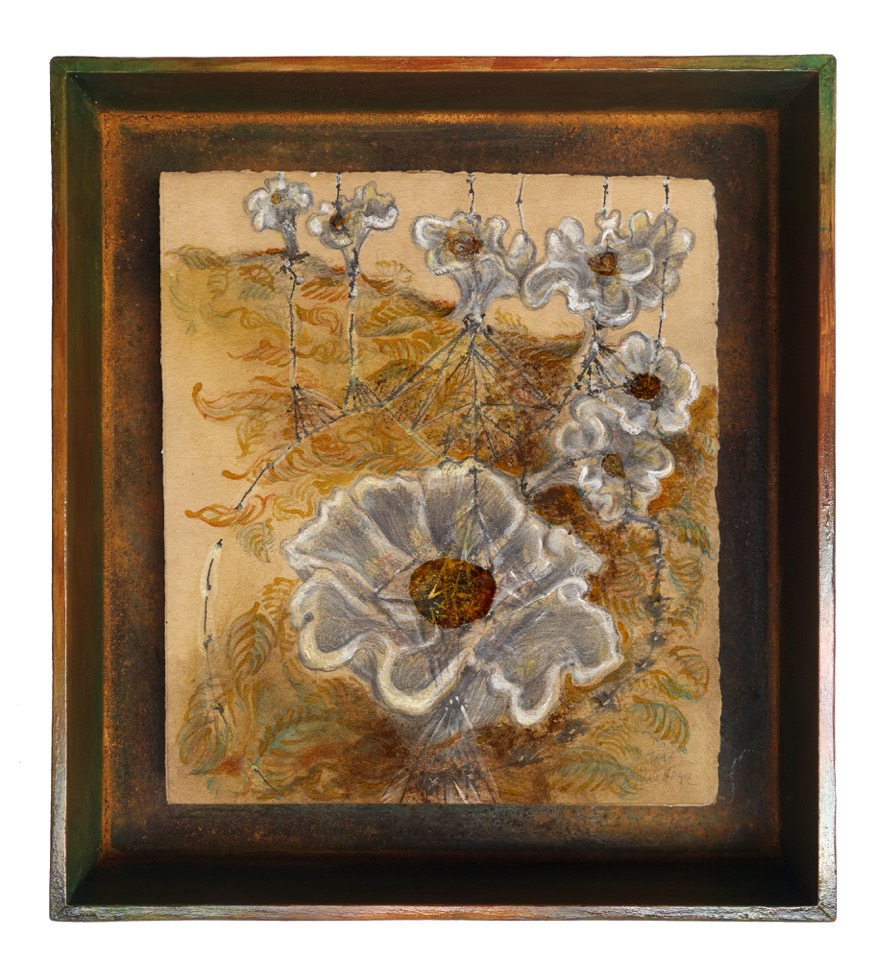P.E. Barbara, I am very pleased that you have agreed to do this interview. I would like to talk to you about your experiences with perception. What is perception for you?
B.M. Yes, when I hear a word like that, I first go etymologically. According to the definition, perception is something that affects the sense organs; one takes in something and becomes sensually-ideally aware of it as a whole. One notices something, is interested in something, becomes involved.
Johannes Stüttgen, the companion of Joseph Beuys, who leads a weekly discussion in which I participate, says: “Concepts/Terms are high beings.” They only reveal themselves to those who have researched and are ready for them. The clarification of concepts, that is, the deep understanding of these conceptual beings, is a grace.
Perception of the world is built on memories, something very subjective, depending on the impression our sense perceptions have left in the brain. If an impression is combined with strong emotions and we really had or have joy or sorrow, the memory stays much longer in the long-term memory because it is more neuronally connected through feelings. That is why it is important that we decide what we let into us.
Apart from the well-known five senses, there is a sixth, actually our largest sense organ, the fascia tissue, “the sixth sense”. Fascia (Latin fascia = ligament) is made of collagen and elastane, something that sticks and something that is flexible. This connective tissue, which holds our body together, flexibly connects all parts of the body to each other. Fascial wrappings continue right down to the smallest detail. Like an orange, first comes the thick outer layer, then thin layers separate the individual slices from each other and finally a very fine, transparent envelope surrounds each individual fibre. The different layers of fascia are equipped with receptors that react to pressure and traction movements, to temperature, pain and stress and report the position of the body in space to the brain.
P.E. This makes me think of the entity of all humanity, with each individual subjectively perceiving something. How does the individual, and thus ultimately a group of people, come closer to an objective truth?
B.M. If something is true, coherent and its message is clear, then it reaches everyone. They don’t have to be spiritually trained people, they don’t have to have a certain education. Especially in art, you notice that if an expression hits something that corresponds to a universal truth, then everyone understands it. That’s why Joseph Beuys says, “Art is the only thing that can change our world.” He doesn’t mean some picture in a gold frame on the wall, but he means the creative power inherent in everyone and everything.
P.E. I would be interested to know how you, as an artist, personally, subjectively, go into mindful awareness.
“Draw me!”
B.M. I love going out into nature, in all types of weather. All my senses are attentive. I notice where my eye lingers, what speaks to me.
We can go to the three works with the mushrooms over there. I call these little works “picture rooms”.

Image 2

Image 3
During an autumn walk I noticed these three groups of mushrooms, one is the Boviste, the second group are the Trichterlinge (funnel balls) in a so-called “witches’ circle” and the third, dark ones are called Totentrompeten (death trumpets). All three “spoke” to me: “Draw me!” For the drawing, I actually sat down in the foliage on the forest floor – I always wear rain trousers for that reason – and then drew the funnelballs quite conventionally at first. They look a bit like swinging skirts, there’s something baroque about these shapes, and the funnels look like fountains. At home, when I was reworking them, I thought I would like to show that these mushrooms are connected underground. With ink I then painted a fine network on the drawing of the mushrooms, which has taken on implied geometric shapes.

Image 4
What fascinates me are these small and large structures in nature, because they are so beautifully ordered. Aesthetics and structure are high values for me. In nature, I also particularly like the forms of transience – right up to mouldering decay. The death trumpets, for example, slowly decay and change their shape and colour in autumn, becoming completely blue-black and glowing when wet.
The objects of perception, in this case the mushrooms, are essential subjects for me, appearances of creation. When they speak to me, the connection is there. I ask, “Where is my service called for“?
P.E. With the luminous, dark, decaying mushrooms, you have succeeded wonderfully in bringing out this iridescence and glow of the still living in the process of decay. The violet painted wooden frame underlines this very nicely.
B.M. The motif itself has the energy and I can carry this into the interior. That means that I work on my picture rooms, i.e. wooden boxes partly built of weathered found wood, in a painterly way. I transfer the colourfulness of the mushroom drawing, in this case the black, the dark blue or the magenta, to the outside of the frame and thereby expand the space of sensory perception.
P.E. You truly come into contact with the living and transforming nature. When you are in nature, not only the eye but the whole person is involved in the contact.
Heart Energy
B.M. Here in Birnbach my sense of smell was strongly stimulated because the air is so fresh and clean. I live in Düsseldorf near the main station, where “mysteries also take place“, says Beuys, but here, nature has a direct effect – especially in autumn – the humidity, the smells, the shapes and colours. I sometimes sit down on the ground, gladly near ferns. Besides, when I see colours, I have something like a taste experience at the same time. The energy of the heart is always involved. In the morning at six o’clock I got up and went out and partly walked barefoot through the dewy grass. Wonderful! Then I discovered the herd of cows, which are sacred animals for me, they came and looked after me. To them I said, “I am your friend, I belong to you, there is also a cow inside me”, and I drew them. I also photographed them in this atmospheric mist that was early in the morning.
P.E. We can find this beautiful autumn scene again in the booklet on the “Birnbach Project”, which you designed on the occasion of the exhibition.
Let’s return to the picture rooms. They demand something quite different from the viewer than your hanging painting panels, which have an immediate, large presence in the room.
“Picture rooms”
B.M. We can go to this work here, which is called Forest, as Birnbach in the Westerwald is richly blessed with them.

Image 5
I prefer to have the picture rooms without any glass at all, so that the work comes into direct contact with the viewer. I trust these pictorial beings, the works, to protect themselves. Here, for example, I have glued in prepared mushrooms and there a dried orchid flower, a carnivorous species by the way; it looks like a scythe. It could be read in the sense of gardeners, but it could also stand for death, the Grim Reaper. In the middle I have drawn in an implied, blessing human being. The forest-picture space merges at the bottom into a kind of reliquary, lined with dark purple velvet, in which you can see tintlings. In former times their sap was used, like a black ink for drawing and writing. By the way, my mother told me that even as a child I was fascinated by these processes of decay and transformation and carried such finds home with me and watched them for weeks. Anyway, when the tintlings were dry, they suddenly looked like thin bones. It’s strange how such a mushroom, which is actually quite soft, becomes something hard. So for me they are the bones of the forest, so to speak, and this luminous purple has something sacred about it.
My picture rooms are an invitation to get very close to them, to engage with them with a bit of an explorer’s spirit. Some of them also contain creatures that fly upwards. To discover them, you have to look closely. They appear like almost unrecognisable, ethereal insect creatures, similar to the invisible mycelium, the fungal network underground.
